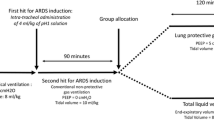Abstract
A sixteen month old girl developed acute respiratory failure from pulmonary oedema, and acute circulatory failure, following postoperative laryngeal obstruction. Her condition deteriorated despite mechanical ventilation with PEEP. She was finally treated with a combination of mild hypothermia, profound muscle paralysis and deep sedation for five days, after which she made a full recovery. This case confirms the previously reported value of such therapy when standard measures fail.
Similar content being viewed by others
References
Donnelly J, Overton JH, Craig CM (1981) Pulmonary oedema following relief of epiglottitis. Anaesth Intens Care 9:280 (letter)
Flachs J, Bookalil M, Clarke B (1977) Extracorporeal oxygenation or hypothermia in respiratory failure. Lancet 1:489 (letter)
Gilston A (1977) The effects of PEEP on arterial oxygenation. An examination of some possible mechanisms. Intensive Care Med 3:267
Jackson FN, Rowland V, Corssen G (1980) Laryngospasm-induced pulmonary oedema. Chest 78:819
Soliman MG, Richer P (1978) Epiglottitis and pulmonary oedema in children. Canad Anaesth Soc J 25:270
Author information
Authors and Affiliations
Rights and permissions
About this article
Cite this article
Gilston, A. A hypothermic regime for acute respiratory failure. Intensive Care Med 9, 37–39 (1983). https://doi.org/10.1007/BF01693705
Accepted:
Issue Date:
DOI: https://doi.org/10.1007/BF01693705




